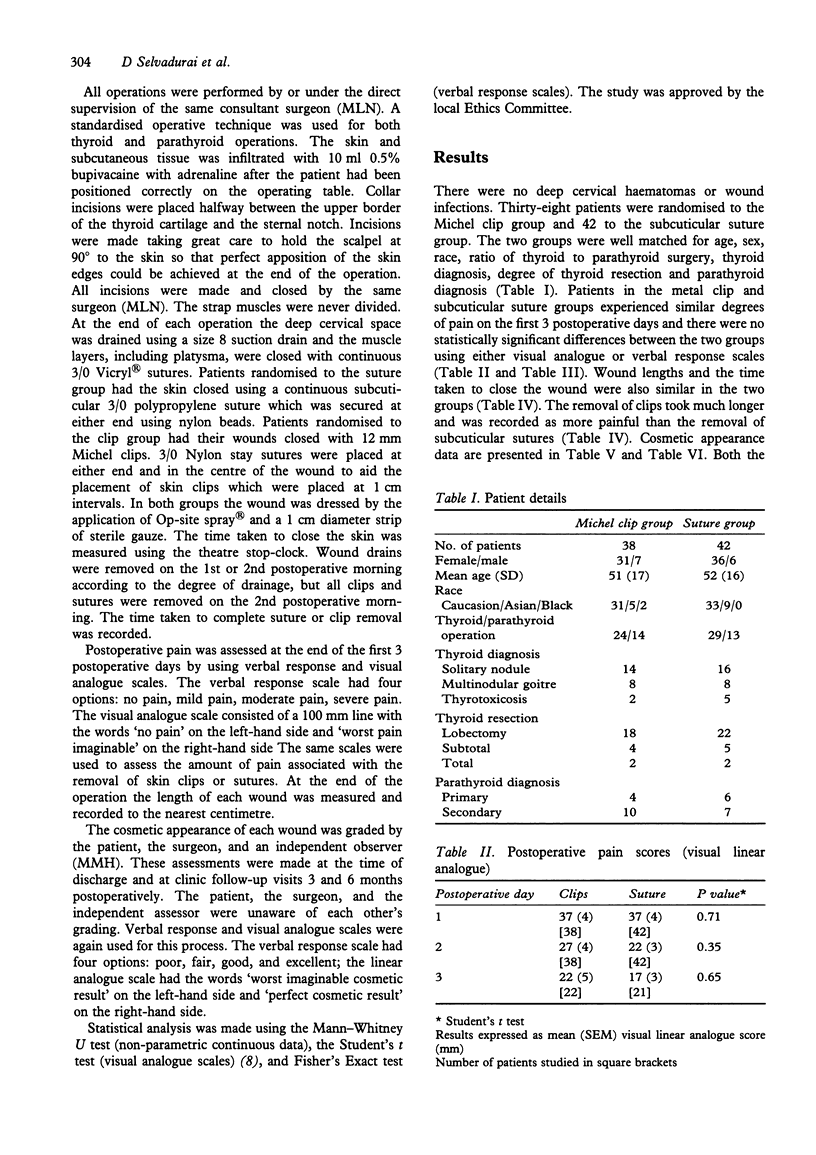Abstract
A randomised trial was conducted to compare the results of neck wound closure using metal (Michel) clips or subcuticular suture. All operations were performed using a standardised technique, which included wound infiltration with 10 ml bupivacaine and adrenaline solution, no strap muscle division and the use of suction drains. All the collar incisions and wound closures were performed by the same surgeon. At the end of each operation patients were randomised to wound closure by either metal clips (n = 38) or a continuous 3/0 prolene subcuticular suture (n = 42). Daily postoperative pain scores and the discomfort caused by clip/suture removal were recorded. The cosmetic appearance of each wound was scored by the patient, the surgeon, and an independent observer using verbal response and linear analogue scales. The two study groups were well matched for age, sex, indication for surgery and operation performed. There were no differences in postoperative pain scores between clips and sutures. Removal of subcuticular sutures was performed more quickly (P < 0.0001) and caused less pain (P < 0.0001, visual analogue scale; P = 0.0042, verbal response scale) than the removal of clips. At the time of discharge, the cosmetic appearance scores generated by the surgeon, patient and independent observer were higher for suture closed wounds than clips. However, by 3 and 6 months follow-up there were no differences in cosmetic appearance between the two methods of closure. Only very short-term cosmetic results are influenced by the type of wound closure in thyroid and parathyroid surgery, but sutures are quicker and less painful to remove than Michel clips.
Full text
PDF



Selected References
These references are in PubMed. This may not be the complete list of references from this article.
- Bucknall T. E., Teare L., Ellis H. The choice of a suture to close abdominal incisions. Eur Surg Res. 1983;15(2):59–66. doi: 10.1159/000128334. [DOI] [PubMed] [Google Scholar]
- Gatt D., Quick C. R., Owen-Smith M. S. Staples for wound closure: a controlled trial. Ann R Coll Surg Engl. 1985 Sep;67(5):318–320. [PMC free article] [PubMed] [Google Scholar]
- Johnson A., Rodeheaver G. T., Durand L. S., Edgerton M. T., Edlich R. F. Automatic disposable stapling devices for wound closure. Ann Emerg Med. 1981 Dec;10(12):631–635. doi: 10.1016/s0196-0644(81)80086-8. [DOI] [PubMed] [Google Scholar]
- Maxwell C. Sensitivity and accuracy of the visual analogue scale: a psycho-physical classroom experiment. Br J Clin Pharmacol. 1978 Jul;6(1):15–24. doi: 10.1111/j.1365-2125.1978.tb01676.x. [DOI] [PMC free article] [PubMed] [Google Scholar]
- Meiring L., Cilliers K., Barry R., Nel C. J. A comparison of a disposable skin stapler and nylon sutures for wound closure. S Afr Med J. 1982 Sep 4;62(11):371–372. [PubMed] [Google Scholar]
- Pickford I. R., Brennan S. S., Evans M., Pollock A. V. Two methods of skin closure in abdominal operations: a controlled clinical trial. Br J Surg. 1983 Apr;70(4):226–228. doi: 10.1002/bjs.1800700414. [DOI] [PubMed] [Google Scholar]
- Stockley I., Elson R. A. Skin closure using staples and nylon sutures: a comparison of results. Ann R Coll Surg Engl. 1987 Mar;69(2):76–78. [PMC free article] [PubMed] [Google Scholar]
- Taube M., Porter R. J., Lord P. H. A combination of subcuticular suture and sterile Micropore tape compared with conventional interrupted sutures for skin closure. A controlled trial. Ann R Coll Surg Engl. 1983 May;65(3):164–167. [PMC free article] [PubMed] [Google Scholar]


